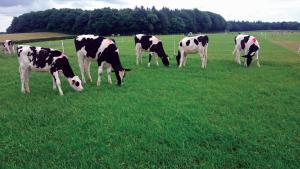Bovine lungworm Dictyocaulus viviparus is the cause of parasitic bronchitis (husk/hoose) in cattle.

The disease is characterised by coughing and respiratory distress, and typically affects young cattle during their first grazing season, following which the surviving animals usually develop a strong immunity. Occasionally, if an older animal with acquired immunity is suddenly exposed to a massive larval challenge from a heavily contaminated field, severe clinical signs may result.
Staff in the Parasitology Section of the Veterinary Sciences Division, AFBI, have noted that the incidence of lungworm infection in cattle is unusually high this year. It is likely that this has been caused by the wet weather in July which, together with the summer temperatures, has created an ideal environment for the survival of lungworm larvae and build-up of high levels of infection on pasture.
Young cattle at grazing initially acquire infection from lungworm larvae that have survived mild winter conditions on pasture which was heavily contaminated in the previous year. Alternatively, they may gain infection from larvae shed by yearling ‘carrier’ cattle that harboured small burdens of immature lungworm from the previous year. The latter come to maturity, releasing larvae unto grass early in the summer and, given the short maturation time on pasture (5-7 days in summer conditions, with adequate moisture), the new generation of worms from infected calves can achieve high levels of contamination on the pasture by late summer.
While lungworms in cattle apparently remain susceptible to destruction by all of the commonly used anthelmintics, in recent years there has been a tendency for lungworm infection to occur in older cattle because treatment with long-acting anthelmintics during the first grazing season has prevented calves from being sufficiently exposed to lungworm infection to develop immunity. Therefore clinical infection can appear in the second, or even in subsequent years at grass, if the pasture is heavily contaminated with larvae.
Affected cattle should be treated as early as possible, with veterinary advice, when signs of coughing or rapid breathing are first seen in the group. This is because severely affected animals may either not respond, or symptoms may be exacerbated, as dead or dying larvae block the lower airways. Indeed, heavily infected animals sometimes die soon after treatment, as the airways become occluded by inflammatory debris and degenerating worms. Treated cattle should be removed from infected pasture and transferred to clean pasture, if available, or housed in well-ventilated facilities. Whatever treatment is selected, it is advisable to divide affected calves into two groups, as the prognosis will vary according to the severity of disease.
Calves which have just commenced coughing or laboured breathing, are usually in the prepatent stage of the disease or have a small adult worm burden, so treatment should result in rapid recovery. Such calves may not have developed a strong immunity and should not be returned to the grazing, which was the source of infection, after treatment. If this is not possible, a macrocyclic lactone may be used, as the residual effect prevents re-infection for an extended period. Calves that are feverish and showing severe signs of lungworm infection should be kept indoors for treatment and observation. Even when affected calves are treated with an anthelmintic, a proportion may not recover, and others may remain permanently stunted. In addition to anthelmintics, severely affected animals may require antibiotics if they have a fever, anti-inflammatories and hydration if they are not drinking.
As lungworm infections are increasingly reported in older animals and adult cows, there may be occasions where milking cattle or beef finishers require treatment. However, to prevent anthelmintic residues in milk and meat, manufacturer’s recommendations for withdrawal times must be observed.
Diagnosis of lungworm infection, prior to administration of treatment, is usually based on the clinical signs of coughing and respiratory effort in grazing cattle. However, it is advisable to seek laboratory confirmation by submitting dung samples from affected animals for identification of lungworm larvae (if infection is patent) and/or carcases of any dead animals for post-mortem examination.
In order to prevent infection in calves exposed to pastures where severe lungworm was diagnosed in the previous year, it is advisable to vaccinate animals older than 8 weeks. Two doses of the live attenuated vaccine should be given 4 weeks apart, and long-acting anthelmintics should be withheld for 2 weeks after the last dose, since these drugs interfere with the development of immunity. Remember that bought-in calves or adult cattle may introduce lungworm onto a farm, so quarantine and treat all incoming cattle.
Notes to editors:
AFBI’s Vision is “Scientific excellence delivering impactful and sustainable outcomes for society, economy and the natural environment”.
AFBI’s Purpose is “To deliver trusted, independent research, statutory and surveillance science and expert advice that addresses local and global challenges, informs government policy and industry decision making, and underpins a sustainable agri-food industry and the natural and marine environments”.
AFBI’s core areas:
- Leading improvements in the agri-food industry to enhance its sustainability.
- Protecting animal, plant and human health.
- Enhancing the natural and marine environment.
Latest news
- AFBI issues Nematodirus warning – Spring 2025 11 April 2025
- Managing Nature Based Risks to the UK Economy and Opportunities for Green Finance 08 April 2025
- AFBI Hillsborough host AERA committee 27 March 2025
- The Omics Days Conference 27 March 2025
